List of noodles
 From Wikipedia - Reading time: 14 min
From Wikipedia - Reading time: 14 min


This is a list of notable types of noodles. A separate list is available for noodle dishes. Noodles are a type of staple food[1] made from some type of unleavened dough which is rolled flat and cut into long strips or strings. Noodles are usually cooked in boiling water, sometimes with cooking oil or salt added. They are often pan-fried or deep-fried. Noodles are often served with an accompanying sauce or in a soup. Noodles can be refrigerated for short-term storage, or dried and stored for future use.
General
[edit]Chinese noodles
[edit]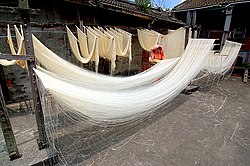
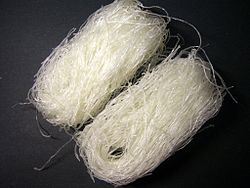

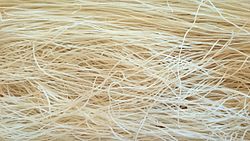
There is a great variety of Chinese noodles, which vary according to their region of production, ingredients, shape or width, and manner of preparation. They are an important part of most regional cuisines within China, as well as in Taiwan, Singapore, and other Southeast Asian nations with sizable overseas Chinese populations.
- Biangbiang noodles
- Cellophane noodles
- Chinkiang pot cover noodles
- Cumian
- Daoxiao noodles
- Dragon beard noodles
- Henan braised noodles
- Hot dry noodles
- Jook-sing noodles
- Kaomianjin
- Lai fun
- Lamian
- Liangpi
- Migan
- Misua
- Mixian
- Mung bean sheets
- Oil noodles
- Paomo
- Rice vermicelli
- Saang mein
- Shahe fen
- Shrimp roe noodles
- Silver needle noodles
- Yi mein
- Youmian
Hong Kong
[edit]Filipino
[edit]- Canton – egg noodles, usually round
- Bihon – rice noodles
- Lomi – thick egg noodles
- Miki – soft yellow egg noodles, usually flat
- Misua – wheat vermicelli
- Palabok – yellow cornstarch noodles
- Sotanghon – glass noodles
Indian
[edit]Indonesian
[edit]- Bakmi
- Bihun – made from rice flour
- Cirambay – made of tapioca
- Kwetiau
- Mie jagung – made from corn starch.
- Mie sagu – made from sago starch.
- Mie singkong/mocaf – made from cassava starch.
- Soun – made from tapioca, ganyong starch, or aren starch. Blue soun also popular with food coloring process.
Japanese
[edit]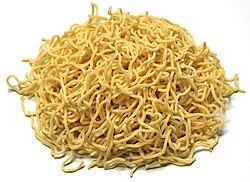

Japanese noodles are a staple part of Japanese cuisine. They are often served chilled with dipping sauces, or in soups or hot dishes.[2]
Korean
[edit]Korean noodles are noodles or noodle dishes in Korean cuisine, and are collectively referred to as guksu in native Korean or myeon (cf. mien) in Sino-Korean vocabulary.
Malaysian
[edit]
Thai
[edit]
Vietnamese
[edit]
Italian
[edit]| Type | Image | Description | Translation | Synonyms | Origin or main area of consumption |
|---|---|---|---|---|---|
| Barbine | Thin strands, often coiled into nests | Little beards[3] | Barbina | ||
| Bavette | 
|
Narrower version of tagliatelle | Bibs[4] | Baverine, bavettine, lasagneddi (in Sicily)[5] | Liguria[5] |
| Bigoli | 
|
Thick, softer, spaghetti-like pasta. Made with whole wheat rather than durum. Sometimes made with duck egg.[6] | From bigolaro, the pasta press used to make bigoli[7] | Fusarioi[6] | Veneto[6] |
| Bucatini | 
|
Thick spaghetti-like pasta with a hole running through the center | Hollow straws[4] Translated from Italian: buco, meaning "hole", and Italian: bucato, meaning "pierced". | Boccolotti, perciatellini, foratini, fidelini bucati, fide bucate, agoni bucati, spilloni bucati[8][9] | Lazio[6] |
| Capellini | 
|
Very thin spaghetti, often coiled into nests. Capelli d'angelo are slightly thinner. | Thin hair, little hair[3] | Angel Hair,[10] Capelli d'angelo, cabellos de angel, capelvenere, fidelini, fedelini, cappellini, sopracappellini, capellini fini, bassetti, tagliolini a nido, barbine a nido, ramicia, vrimiciddi[9][11] | Liguria[6] |
| Fedelini | 
|
Very thin spaghetti[12] | Little faithful ones | Naples, Genoa and Liguria[13] | |
| Fettuccine | 
|
Ribbon of pasta approximately 6.5 millimeters wide. Larger and thicker than tagliatelle[14] | Little ribbons:[15] from affettare, "to slice".[14] | Lasagnette, fettucce, ramicce, sagne[9][14] | Rome[14] |
| Linguine | 
|
Flattened spaghetti | Little tongues[4] | Bavettine, bavette fini, radichini, linguettine[9] | |
| Lagane[16] | |||||
| Maccheroni alla molinara | 
|
Very thick, long, hand-pulled pasta. | The miller’s wife’s pasta | Abruzzo | |
| Maccheroncini di Campofilone | 
|
Thin strands of egg-based pasta. Similar to Capelli d'angelo. | Marche[17] | ||
| Mafalde | 
|
Long rectangular ribbons with ruffled sides. | Named in honor of Princess Mafalda of Savoy[16][18] | Reginette, frese, tagliatelle nervate,[9] signorine, trinette, ricciarelle, sfresatine, nastri, nastrini[18] | Naples[18] |
| Matriciani | Similar to perciatelli, but folded over rather than hollowed out | ||||
| Pappardelle | 
|
Thick flat ribbons[19] of egg-based dough | From Tuscan papparsi, "to pig out".[20] | Papparelle,[9] paparele (Veneto); paspardelle (Marche)[20] | Tuscany and northern Italy[20] |
| Perciatelli | 
|
"Virtually identical to bucatini"[21] | From perciare, "to hollow" | Maccheroncelli, Maccheronicini, Mezzanelli, Long Macaroni[9] | Campania[6] |
| Pici | 
|
Very thick, irregular and long, hand-rolled pasta.[22] | From appiciare, "to stick".[22] | Lunghetti (Montalcino); pinci (Montepulciano); umbrici/ciriole (Umbria)[22][23] | Tuscany[22] |
| Rustiche | 
|
Serrated ribbons | literally the feminine plural of rustico, meaning 'rustic'[24] | Apulia | |
| Sagne 'ncannulate | 
|
Long tube formed of twisted ribbon | Caned lasagne | ||
| Spaghetti | 
|
A long, thin, cylindrical pasta of Italian origin, made of semolina or flour and water.[25] Spaghettini and spaghettoni are slightly thinner or thicker, respectively.[26] | "Little strings".[4] Spaghetti is the plural form of the Italian word spaghetto, which is a diminutive of spago, meaning "thin string" or "twine".[25] | Fide/fidi, fidelini, ristoranti, vermicelloni, filatelli, vermicelloni giganti[9][26] | Sicily |
| Spaghetti alla chitarra | 
|
Square spaghetti,[27] made of egg and flour | Named after the guitar-like device used to cut the pasta,[27] which has a wooden frame strung with metal wires, sheets of pasta are pressed down onto the device, and then the wires are "strummed" so the slivers of pasta fall through. | Tonnarelli, maccheroni alla chitarra | Abruzzo |
| Spaghettini | A slightly thinner version of spaghetti[28] | Thin spaghetti[28] | Thin spaghetti | ||
| Spaghettoni | 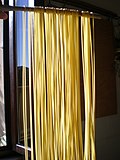
|
A slightly thicker version of spaghetti[26] | Thick spaghetti | Spaghetti spessi | |
| Stringozzi | 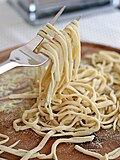
|
Similar to shoelaces | Shoestring-like, shoelaces[29] | ||
| Su Filindeu | Extremely rare pasta, made of thinly pulled and folded dough which is laid in the sun to dry.[30] | The threads (or wool) of God[30] | Sardinia[30] | ||
| Tagliatelle | 
|
Ribbons of egg-based pasta.[31] Generally narrower than fettuccine. | From the Italian tagliare, meaning "to cut".[31] | Tagliarelli, reginelle, fresine, nastri, fettuccelle, fettucce romane, fiadi, tagliolini; tagliatelle smalzade (Trentino); lesagnetes (Veneto); bardele (Lombardia); fettuccine (Lazio); pincinelle (Colonna); tagghiarini (Sicily); taddarini (Sardinia)[9][31] | Emilia-Romagna (part. Bologna)[31] |
| Tagliolini | 
|
Thinner version of tagliatelle | From the Italian tagliare, meaning "to cut". | Tagliolini; tagliatini (Tuscany); tajarin (Piedmont)[32] | Liguria, Piedmont[32] |
| Testaroli | 
|
Thin spongy pasta described as "the earliest recorded pasta" | Based upon the testo, a terracotta or cast iron cooking device with a hot, flat surface that testaroli is traditionally cooked on | Lunigiana | |
| Trenette | 
|
Thin ribbon ridged on one side. Slightly thicker than linguine. | |||
| Tripoline | Thick ribbon ridged on one side[33] | Signorine[9] | |||
| Vermicelli | 
|
A traditional pasta round that is thinner than spaghetti.[34][35] | Little worms[4][36] | Campania[6] | |
| Ziti | 
|
Long, narrow hose-like tubes[19] larger than mezzani (also called mezzi ziti) or bucatini that are traditionally broken before being put to cook.[37] The addition of the word rigati (e.g. ziti rigati) denotes lines or ridges on the pasta's surface. Ziti candelati are longer, zitoni a bit larger. | Bride and bridegroom (ziti is plural) in Sicilian dialect.[37] | Boccolotti, zitoni, zituane, candele, ziti candelati[9][37] | Sicily,[38] Southern Italy[37] |
Other Asian noodles
[edit]Other European noodles
[edit]
See also
[edit]References
[edit]- ^ 4,000-Year-Old Noodles Found in China
- ^ Sakui, S. (2009, July 1st). Somen: Chilled, the Japanese Noodles are a Summer Delight. Los Angeles Times. Retrieved January 9th, 2010
- ^ a b Cosmo, S. (2017). The Ultimate Pasta and Noodle Cookbook. Cider Mill Press. p. 85. ISBN 978-1-60433-733-4. Retrieved 30 December 2019.
- ^ a b c d e Kostioukovitch, Elena (October 13, 2009). Why Italians Love to Talk About Food: A Journey Through Italy's Great Regional Cuisines, From the alps to Sicily. Farrar, Straus and Giroux. ISBN 9781429935593 – via Google Books.
- ^ a b Zanini De Vita 2009, pp. 117–118.
- ^ a b c d e f g Hildebrand & Kenedy 2011, p. 28.
- ^ Hildebrand & Kenedy 2011, p. [page needed].
- ^ Hildebrand & Kenedy 2011, p. 34.
- ^ a b c d e f g h i j k "Pasta-shapes". www.food-info.net. Retrieved 12 November 2017.
- ^ "Pasta Products, Enriched and Whole Wheat, p.2" (PDF).
- ^ Hildebrand & Kenedy 2011, p. 54.
- ^ Marchetti, Domenica (2011). The Glorious Pasta of Italy. Chronicle Books. p. 122. ISBN 1452106908
- ^ "Fedelini | Local Pasta Variety From Italy". www.tasteatlas.com. Retrieved 9 February 2021.
- ^ a b c d Hildebrand & Kenedy 2011, p. 100.
- ^ "The Ministry – Perfect Pasta Shapes – Geometry Of Pasta". Geometry Of Pasta. Retrieved 7 November 2017.
- ^ a b Zanini De Vita 2009, pp. 145–147.
- ^ "Maccheroncini di Campofilone: Marche's 600-year-old pasta". Great Italian Chefs. 22 May 2018. Retrieved 29 July 2018.
- ^ a b c Hildebrand & Kenedy 2011, p. 214.
- ^ a b Rosso, J.; Lukins, S. (1989). The New Basics Cookbook. Workman Publishing Company. p. 130. ISBN 978-0-89480-392-5. Retrieved 30 December 2019.
- ^ a b c Hildebrand & Kenedy 2011, p. 184.
- ^ Andrews, C.; Hirsheimer, C.; Batali, M. (2012). Country Cooking of Italy. Chronicle Books. p. pt91. ISBN 978-1-4521-2392-9. Retrieved 30 December 2019.
- ^ a b c d Hildebrand & Kenedy 2011, p. 198.
- ^ "Le ricette della tradizione". Umbria tourism (in Italian). Retrieved 19 January 2018.
- ^ "rustiche - Wiktionary". en.wiktionary.org. Retrieved 3 January 2020.
- ^ a b Definition of spaghetti. Dictionary.com. Dictionary.com Unabridged (v 1.1). Random House, Inc. (accessed: 3 June 2008).
- ^ a b c Hildebrand & Kenedy 2011, p. 230.
- ^ a b Luongo, P.; Strausman, M.; Hirsheimer, C. (2007). Two Meatballs in the Italian Kitchen. Artisan. p. 112. ISBN 978-1-57965-345-3. Retrieved 3 January 2020.
- ^ a b Vos, H. (2010). Passion of a Foodie - An International Kitchen Companion. Strategic Book Publishing & Rights Agency. p. 406. ISBN 978-1-934925-63-8. Retrieved 30 December 2019.
- ^ Zibart, E. (2010). The Ethnic Food Lover's Companion: A Sourcebook for Understanding the Cuisines of the World. Menasha Ridge Press. p. pt68. ISBN 978-0-89732-775-6. Retrieved 30 December 2019.
- ^ a b c "Sardinia's Su Filindeu: The Rarest Pasta in the World". April 20, 2021.
- ^ a b c d Hildebrand & Kenedy 2011, p. 248.
- ^ a b Hildebrand & Kenedy 2011, p. 254.
- ^ Steves, R. (2017). Rick Steves' Italian Phrase Book & Dictionary. Avalon Publishing. p. 136. ISBN 978-1-63121-749-4. Retrieved 30 December 2019.
- ^ "Definition of Vermicelli". Merriam-Webster. 11 December 2019. Retrieved 3 January 2020.
- ^ "Pasta Products, Enriched and Whole Wheat" (PDF).
- ^ Wheeler, Jen (5 March 2019). "What Is Vermicelli?". Chowhound. Retrieved 3 January 2020.
- ^ a b c d Hildebrand & Kenedy 2011, p. 282.
- ^ Drezga, Stephen (29 July 2019). "ARCHAEOLOGY OF PASTA - Ziti". Chef's Mandala. Retrieved 28 August 2020.
External links
[edit] Media related to Noodles at Wikimedia Commons
Media related to Noodles at Wikimedia Commons Media related to Noodle-based food at Wikimedia Commons
Media related to Noodle-based food at Wikimedia Commons Media related to Noodles by country at Wikimedia Commons
Media related to Noodles by country at Wikimedia Commons Media related to Noodles from China at Wikimedia Commons
Media related to Noodles from China at Wikimedia Commons Media related to Noodles from Indonesia at Wikimedia Commons
Media related to Noodles from Indonesia at Wikimedia Commons Media related to Noodles from Japan at Wikimedia Commons
Media related to Noodles from Japan at Wikimedia Commons Media related to Noodles from Korea at Wikimedia Commons
Media related to Noodles from Korea at Wikimedia Commons Media related to Noodle dishes of Laos at Wikimedia Commons
Media related to Noodle dishes of Laos at Wikimedia Commons Media related to Noodle dishes of Malaysia at Wikimedia Commons
Media related to Noodle dishes of Malaysia at Wikimedia Commons Media related to Noodle dishes of Thailand at Wikimedia Commons
Media related to Noodle dishes of Thailand at Wikimedia Commons Media related to Noodle dishes of Singapore at Wikimedia Commons
Media related to Noodle dishes of Singapore at Wikimedia Commons Media related to Noodles from Vietnam at Wikimedia Commons
Media related to Noodles from Vietnam at Wikimedia Commons
 KSF
KSF